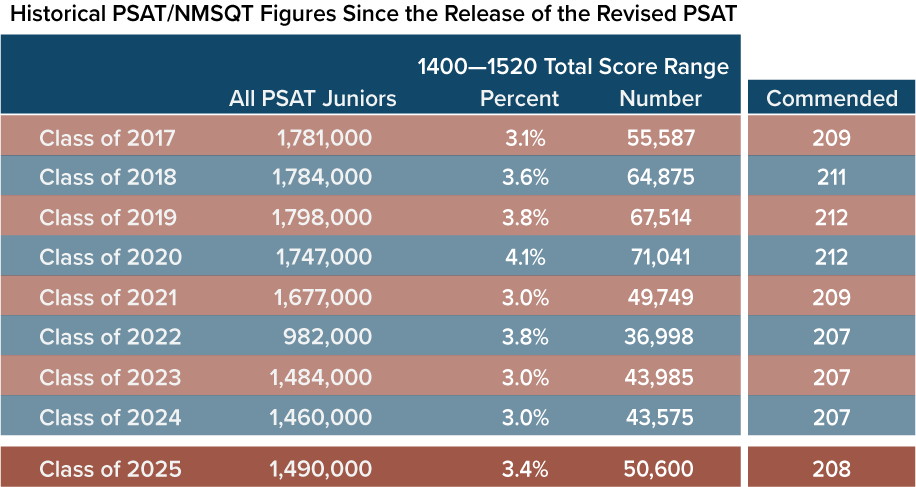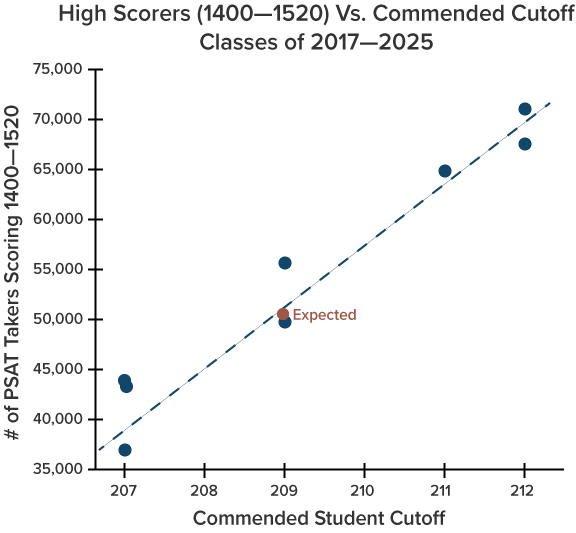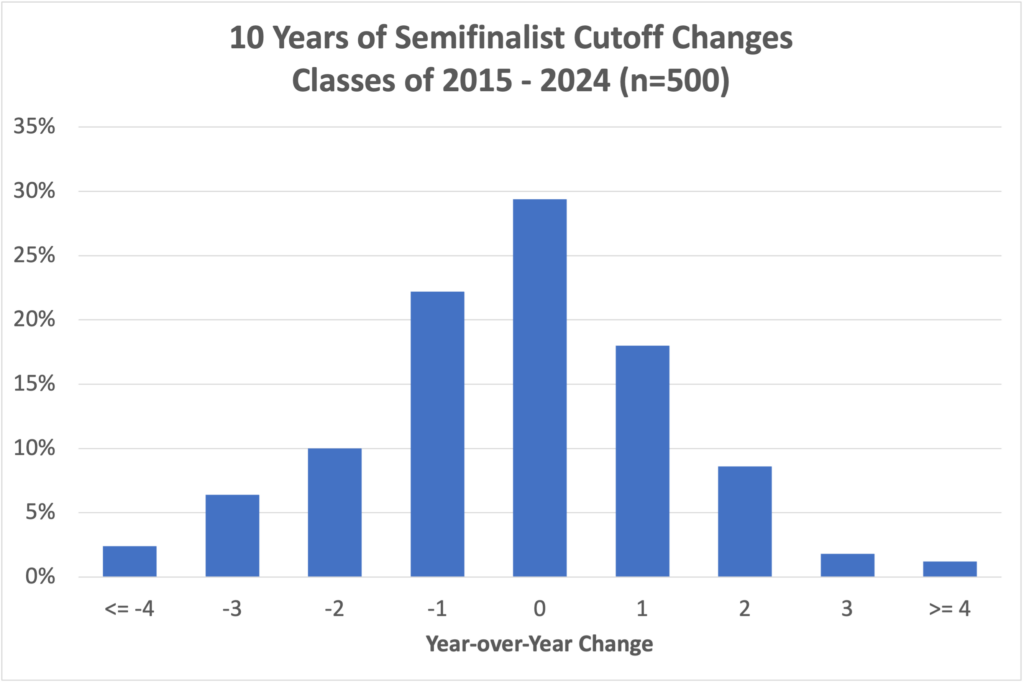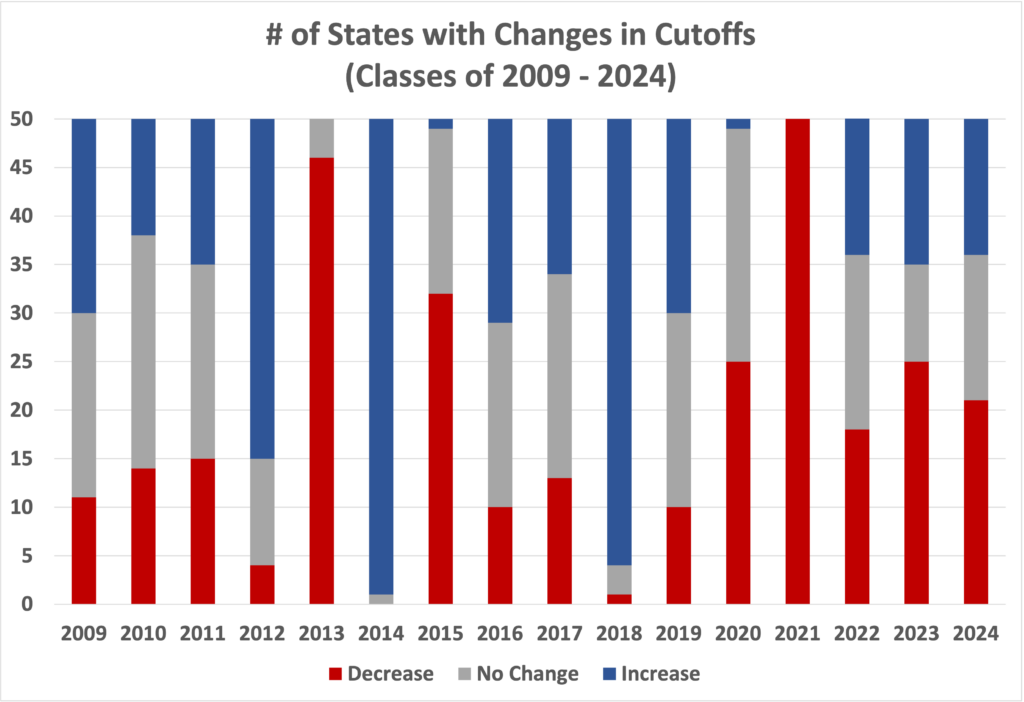
April 8 Update:
The Commended cutoff — the minimum score to be considered for National Merit honors — for the class of 2025 is 208. This is the highest cutoff in 4 years. Compass’s analysis of the results from the first digital PSAT showed that the Commended cutoff would fall in the 208 – 210 range, so the 208 is in line with expectations.
Compass has incorporated the Commended cutoff into its projections for the Semifinalist cutoffs, which will begin filtering out around Labor Day.
Why haven’t I been told anything by my school?
The April announcement is to schools only and is not an official notification of a student’s status. Honored students are not notified until September.
Why aren’t Semifinalist cutoffs announced at the same time?
National Merit must receive student eligibility information from schools and then calculate the separate Semifinalist cutoffs for each state. Only the Commended cutoff is national. NMSC will mail high schools the names of Semifinalists at the end of August, and students will be notified by their schools in early to mid-September. Schools are not given the Commended Student letters until after Semifinalists are announced.
[The November 2023 post below has been updated with the Commended cutoff information.]
The 2023 digital PSAT/NMSQT for the class of 2025 represents the biggest change to the National Merit Scholarship Program since the PSAT was overhauled in 2015. Each year Compass looks at the results from the PSAT and tracks projected Selection Index cutoffs for Commended Students and for Semifinalist in each of the 50 states. [See National Merit Scholarship Program Explained for full details on stages and instructions. For information on the class of 2024 cutoffs, see this archive.]
Instead of having schools administer a paper test on fixed dates, College Board allowed the digital PSAT to be offered throughout October. College Board also introduced a new score return policy. Students taking the test on or before October 14th receive scores on November 6th. Students taking the PSAT after October 14th receive their scores on November 16th. Compass now has the data from both release windows. Approximately 50,000 students landed in the 1400-1520 score band from almost 1.5 million test takers. The initial half of scores already accounted for 30,000 of top band scores, so the later testers had a lower proportion of high scorers. This will come as a relief to students who were fearing an extremely large jump in Selection Index cutoffs.
This year is shaping up similar to the class of 2021 (the last pre-pandemic PSAT) and, reaching back farther, the class of 2017.
The number of top scorers is the most critical piece of information that we get this early in the process. There is a strong correlation between the 1400-1520 band of students and the Commended Student score.
[We now know the exact Commended cutoff is 208. -Ed.] The Commended Student cutoff is likely to rise to 209 (above the 207 from the last 3 years). Estimates can be imperfect, but we are confident that the Commended cutoff will fall within the 208 to 210 range. The higher Commended cutoff, in turn, correlates with higher Semifinalist cutoffs. Below are those estimates.
| State | Class of 2025 (Most Likely) | Class of 2025 (Est Range) | Class of 2024 (Actual) | Class of 2023 (Actual) | Class of 2022 (Actual) |
|---|---|---|---|---|---|
| Alabama | 212 | 210 - 216 | 210 | 212 | 212 |
| Alaska | 212 | 209 - 215 | 209 | 210 | 208 |
| Arizona | 217 | 214 - 220 | 216 | 214 | 218 |
| Arkansas | 212 | 209 - 215 | 210 | 210 | 211 |
| California | 221 | 219 - 223 | 221 | 220 | 221 |
| Colorado | 217 | 215 - 220 | 216 | 217 | 217 |
| Connecticut | 221 | 219 - 222 | 221 | 221 | 220 |
| Delaware | 220 | 218 - 222 | 219 | 218 | 220 |
| District of Columbia | 223 | 222 - 224 | 223 | 223 | 224 |
| Florida | 216 | 215 - 219 | 216 | 216 | 217 |
| Georgia | 219 | 216 - 220 | 217 | 218 | 219 |
| Hawaii | 217 | 215 - 220 | 217 | 215 | 217 |
| Idaho | 214 | 210 - 216 | 211 | 215 | 214 |
| Illinois | 219 | 217 - 221 | 219 | 219 | 218 |
| Indiana | 216 | 213 - 219 | 216 | 214 | 215 |
| Iowa | 213 | 210 - 216 | 210 | 212 | 211 |
| Kansas | 215 | 213 - 218 | 214 | 214 | 215 |
| Kentucky | 214 | 210 - 217 | 211 | 212 | 212 |
| Louisiana | 214 | 211 - 217 | 214 | 213 | 213 |
| Maine | 214 | 211 - 217 | 213 | 215 | 211 |
| Maryland | 222 | 219 - 223 | 221 | 222 | 224 |
| Massachusetts | 222 | 220 - 223 | 222 | 220 | 221 |
| Michigan | 217 | 215 - 220 | 217 | 218 | 217 |
| Minnesota | 218 | 215 - 220 | 216 | 216 | 218 |
| Mississippi | 211 | 209 - 215 | 209 | 210 | 213 |
| Missouri | 215 | 212 - 218 | 214 | 213 | 214 |
| Montana | 210 | 208 - 214 | 209 | 207 | 208 |
| Nebraska | 213 | 209 - 216 | 210 | 212 | 210 |
| Nevada | 214 | 210 - 218 | 211 | 210 | 214 |
| New Hampshire | 215 | 213 - 219 | 215 | 213 | 214 |
| New Jersey | 223 | 222 - 224 | 223 | 223 | 222 |
| New Mexico | 211 | 208 - 214 | 207 | 208 | 210 |
| New York | 220 | 218 - 222 | 220 | 219 | 220 |
| North Carolina | 218 | 215 - 220 | 217 | 217 | 218 |
| North Dakota | 208 | 208 - 210 | 207 | 209 | 207 |
| Ohio | 216 | 214 - 218 | 216 | 216 | 215 |
| Oklahoma | 211 | 209 - 215 | 208 | 211 | 210 |
| Oregon | 217 | 215 - 220 | 216 | 216 | 220 |
| Pennsylvania | 219 | 217 - 221 | 219 | 218 | 218 |
| Rhode Island | 216 | 213 - 219 | 215 | 216 | 213 |
| South Carolina | 213 | 209 - 217 | 209 | 213 | 213 |
| South Dakota | 211 | 208 - 214 | 209 | 212 | 210 |
| Tennessee | 216 | 214 - 219 | 217 | 215 | 215 |
| Texas | 220 | 218 - 221 | 219 | 219 | 220 |
| Utah | 212 | 209 - 216 | 209 | 211 | 212 |
| Vermont | 213 | 210 - 217 | 212 | 213 | 211 |
| Virginia | 221 | 219 - 222 | 219 | 221 | 221 |
| Washington | 220 | 218 - 222 | 220 | 220 | 220 |
| West Virginia | 208 | 208 - 210 | 207 | 207 | 207 |
| Wisconsin | 214 | 212 - 217 | 213 | 213 | 214 |
| Wyoming | 208 | 208 - 210 | 207 | 207 | 208 |
| U.S. Territories | 208 | 208 | 207 | 207 | 207 |
| Studying Abroad | 223 | 222 - 224 | 223 | 223 | 224 |
| Commended | 208 | 208 | 207 | 207 | 207 |
[See Compass’s National Merit Historical Cutoffs post for data going back to the class of 2008, which can be helpful in comparing this year to its analogues.]
The shift to a shorter, online and adaptive exam is unlikely to wreak the havoc we saw when the “revised PSAT” was introduced 8 years ago. That test overhauled content AND scoring. The digital SAT represents a content change — mainly on Reading and Writing — but keeps the 320-1520 score range intact. The Selection Index, too, remains consistent, with the Reading and Writing score having twice the weight of the Math score.
However, for any given state, a change in cutoff is more likely than not. Historically, Semifinalist cutoffs remain unchanged only about one-third of the time.
Even in years where the Commended cutoff remains static, we see half of state cutoffs go up or down. And it is extremely improbable that the Selection Index will be static. The chart below divides the 50 states into those that saw increases (blue), those that remained unchanged (gray), and those that saw declines (red). We are likely to see a year with far more blue than gray and more gray than red.
Uncertainty around exactly which state cutoffs will change and by how much is why we encourage students to compare their scores to the full estimated range in the table above rather than to a single value (our “Most Likely”). These estimates are built from prior performance data and from data on what scores are doing nationally. State and national numbers are not always in alignment. Cutoffs are particularly bumpy in states with smaller pools of test takers and National Merit Semifinalists. Over the last 10 years, large states’ cutoffs have remained within 1 point of the prior cutoff 88% of the time. That figure drops to 73% for midsized states and 53% for small states. No large state’s cutoff has jumped by more than 3 points in a year, whereas 6-point changes have occurred in the pool of smaller states. Scores also tend to be more stable as they get higher. It is more unusual for a state to move from 221 to 222, for example, than for a state to move from 212 to 213.
What does a cutoff mean? Do I need to score at the cutoff or above it?
Students must have a Selection Index at or above the official cutoff in order to qualify for National Merit honors.
The top 52,000 to 54,000 students will receive some form of honors. National Merit Scholarship Corporation (NMSC) determines the cutoff number that comes closest to producing the target number of national honorees. This is the Commended cutoff.
How are Semifinalist cutoffs set?
Unlike the national Commended cutoff, Semifinalist cutoffs are calculated state by state. NMSC allocates the 16,000 semifinalists among states based on the annual number of high school graduates. For example, California sees about 2,000 Semifinalists every year, Michigan 500, and Wyoming 25. In each state, NMSC determines the Selection Index that comes closest to matching its target number of Semifinalists. If 1,900 California students score 222 and higher and 2,050 score 221 or higher, then the Semifinalist cutoff would be 221 (this assumes that the target is exactly 2,000). Because score levels can get crowded, it is easy for cutoffs to move up or down a point even when there is minimal change in testing behavior or performance.
No Semifinalist cutoff can be lower than the national Commended level. Cutoffs for the District of Columbia and for U.S. students studying abroad are set at the highest state cutoff (typically New Jersey). The cutoff for students in U.S. territories and possessions falls at the Commended level each year. Boarding schools are grouped by region. The cutoff for a given region is the highest state cutoff within the region.
Why does the number of top scorers vary from year to year?
While there are changes in the number of students taking the PSAT/NMSQT, there can also be small flaws in test scaling that play a role. Prior to the digital PSAT, a single test form was seen by a large percentage of test takers. Something amiss with that single form could impact selection cutoffs across the country. The digital PSAT is constructed differently. Students receive unique form codes drawn from a large pool of problems. Scaled scores are generated based on the characteristics of those problems. In theory, this should make scores more stable. College Board’s early studies have found an extremely high correlation between the paper-and-pencil test and digital test. Still, even with its adaptive nature, the uncertainty remains as to whether the much shorter test can reliably score students at the 700-760 end of the scale. It appears that the class of 2025 is roughly average compared to the classes of 2017 to 2024 (the years after the change from the 2400 to 1520 scale).
Will test cancellations raise or lower qualifying scores for the National Merit Scholarship Program?
College Board’s online systems failed under load on one of the biggest testing days. There was also a bug that prevented iPads on the latest operating system from submitting exams. We do not know how many schools or students simply gave up and did not retest on rescheduled dates. If the cancellations increase the number of students pursuing alternate entry (see Compass’s explanation of National Merit alternate entry) then cutoffs could rise. Alternate entrants tend to have higher scores, because they can submit SAT scores through June 2024 to enter the competition. They must apply by April.
When are National Merit Semifinalists announced?
The Commended cutoff becomes unofficially known by the end of April. The lists of Semifinalists are not distributed to high schools until the end of August. NMSC sets a press embargo on Semifinalist announcement until mid-September, but schools are allowed to notify students before that date. NMSC does not send Commended Student letters to high schools until mid-September. Compass will keep students updated on developments as those dates approach.
Do state and national percentiles indicate whether I will be a National Merit Semifinalist?
No! Approximately 1% of test takers qualify as Semifinalists each year, so it is tempting to view a 99th percentile score as indicating a high enough score — especially now that College Board provides students with percentiles by state. There are any number of flaws that rule out using percentiles as a quick way of determining National Merit status.
- Percentiles are based on section scores or total score, not Selection Index
- Percentiles are rounded. There is a large difference, from a National Merit perspective, between the top 0.51% and the top 1.49%
- Percentiles reveal the percentage of students at or below a certain score, but the “at” part is important when NMSC is determining cutoffs.
- The number of Semifinalists is based on the number of high school graduates in a state, not the number of PSAT takers. Percentiles are based on PSAT takers. States have widely varying participation rates.
- Most definitive of all: Percentiles do not reflect the current year’s scores! They are based on the prior 3 years’ performance. They are set even before the test is given. And if you are going to use prior history, why not use the completely accurate record of prior National Merit cutoffs rather than the highly suspect percentiles?
Entry requirements for National Merit versus qualifying for National Merit.
Your PSAT/NMSQT score report tells you whether you meet the eligibility requirements for the NMSP. In general, juniors taking the October PSAT are eligible. If you have an asterisk next to your Selection Index, it means that your answers to the entrance questions have made you ineligible. Your answers are conveniently noted on your score report. If you think there is an error, you will also find instructions on how to contact NMSC. Meeting the eligibility requirements simply means that your score will be considered. Approximately 1.4 million students enter the competition each year. Only about 52,000 students will be named as Commended Students, Semifinalists, Finalists, or Scholars. See National Merit Explained for more information.





Thank you for this great article during a time of so many questions and a lengthy timeline of waiting! Our son is at 216 in Kansas….chances??
The 216 falls in the 50-75% range, I think. It’s been high enough the last 3 years, but it would have fallen short the 3 years before that. I think continuing the current streak is more likely.
Hello, my son received an index score of 225 and with actual PSAT score of1500 in FL. Does he qualify for national merit scholarship and what kind do you think if he does? Thank you.
Gina,
The National Merit competition proceeds in several stages. Your son’s score will make him a Semifinalist and eligible to apply for the next stage. In order to become a Finalist, he’ll fill out an application (next September). He’ll need a strong SAT score (which he already has), extremely strong grades (no hard cutoff is given), and the recommendation of his school. About 15,000 Semifinalists out of 16,000 become Finalists. Then Finalists are considered for scholarships. You can read more about that on our FAQ.
May I ask a follow-up question regarding the Semifinalist process? My homeschooled junior just scored 1470 with a SI of 219 in Kansas. If he is a Semifinalist and proceeds to the next steps (strong SAT, strong grades, etc), what does National Merit accept alternatively for the recommendation of his school? Thank you for this very helpful article!
Amy,
A 219 will qualify (congratulations!), so it’s correct to look ahead to the next stage. NMSC *really* wants a recommendation from a non-parent who has insight into the student’s academic performance. In some cases, that’s just not possible. It’s best to discuss your situation with NMSC. This won’t matter until next October, so you have plenty of time!
Hello. Do you see the cutoff moving much in VA from 221? My son received a 221 and I was wondering what his chances were to be a semifinalist.
Markel,
It’s not likely to move more than a point in either direction. Given how closely the national numbers are tracking last year’s, I like the chances of 221.
Would a 211 in Arkansas look promising for NM? What do you think is the situation of AR (since it is a lower cutoff state)?
Also, do we have to get higher than the cutoff for NM, or can we equal it and still get NM?
CJ,
As long as your score is equal to the cutoff or higher, you will qualify. It’s not a given, but I think 211 looks promising. As a small state, Arkansas sees a lot of fluctuation. It’s had as high as 215 and as low as 209 in the last decade.
Thank you; this is very helpful! What are the chances of the MO semifinalist cutoff being above 214?
Janelle,
In the 4 years that I consider the closest analogues (nationally, at least), a 214 qualified in Missouri 3 times. I think 1/4 sounds about right for MO going to 215 or above.
Hi Art, Thank you for the informative article. My daughter scored a 1370, at 99 percentile, which I assumed meant she scored in the top 1%. How can this be if 3% scored 1400+? Am I misreading what the 99 percentile means? Thanks!
Ann M,
It’s not you. College Board does an abysmal job at presenting percentiles. The one you are seeing is based on a “nationally representative sample.” That means it is an estimate of what the percentile would be if EVERY student in the U.S. took the exam. The actual PSAT takers are more likely to be on a college track. If you drill deeper into the report you’ll find a “User Percentile.” That’s based on actual test takers from the 2019, 2020, and 2021 PSATs. A 1370 is the 95th percentile on that metric.
Daughter scored 210 in Oklahoma. Looks she’ll be a point or two shy. Thoughts?
Oklahoma is usually within 3 or 4 points of the Commended level, so we will know more in April when that leaks. Good luck!
My daughter received a 218 score in NY and I know last year was 219. Is there essentially no likelihood that she could be a semifinalist? What a shame when you are literally one point away!!
J,
It’s possible, but 219 was a 10-year low for New York. As we see every year, though, 1-point shifts are common.
What do you think the chances are of commended cutoff being 206?
Ann,
While I think 207 and 208 are more likely, I don’t think we can exclude 206. I do think it’s fairly unlikely given that we didn’t see the cutoff drop below 207 even for the class of 2022.
Hey Art. I got a selection index score of 215 in Michigan. What do you think are my chances of qualifying as a semifinalist? Thanks so much!
Ethan,
Once Michigan switched from having students take the ACT to having them take the SAT, the state’s cutoff surged. It hasn’t been below 216 since that time. We are in weird times, so just about anything is possible.
A Student from Illinois got perfect score on math and ERW 710 i.e., total score 1470 (SI 218) will they qualify for semifinalist. Thanks for the reply!
Ann,
It will be tight. In the 4 years I look to as indicative of “low years,” Illinois had a 218 cutoff in 1 of them. So we know it can happen.
would 214 in NJ be a commended scholar.TY!
Vidia,
Yes, it will be Commended.
Score of 222 in California. What is the likelihood of semifinalist? Thank you for all you do! Appreciate it.
Kelly,
I’m confident that you will qualify. Congratulations!
Art, thanks for the great info. What are your thoughts on an index of 217 in Colorado? What is the probability of making semifinalist? Is CO considered a relatively stable state in terms of PSAT scores historically?
Jen,
Colorado has been stable once you account for the national shifts from high years and low. If I look at the 4 low years, CO has had cutoffs of 217, 217, 217, and 218. For high years, the cutoffs were 220, 220, 221. So the risks for you are (1) I am wrong about it being a low year and (2) that CO skews toward 218 or 219. I’d put yours odds at 50-75%.
Thank you for this information! Is the Commended cutoff a national one or is that also determined by each state? And, if scores were lower this year, any chance the Commended cutoff could be 206 (rather than the “likely 207”?
Cat,
It’s possible. The fact that the Commended level didn’t go beneath 207 even in the pandemic class of 2022, though, makes me think it is less likely than 207 or 208.
My daughter received a 219 in OK. What are her Semifinalist chances?
DP,
She is a lock for Semifinalist. Congratulations!
Hi Art, thank you very much for the information. My son is in MN and got 213, any chance of qualifying as a semifinalist?
Lo,
I don’t believe MN’s cutoff will go as low as 213 this year.
Thank you so much Mr. Art for the great information and answering all with wonderful patience and empathy! My Son got 1470 PSAT and 221 Index from Virginia. His SAT is 1590. How are the chances for NMSC?
Sheri,
Wow! His 1590 will be great for colleges, but it doesn’t come into play for NM unless and until he is named a Semifinalist. I think his chances are good. A 222 in VA would be unusual in a year when so few students seem to have earned top scores.
Hi Art, Very informative article. Thank you very much for sharing your insights. For the Commended cutoff (207), your analysis is based on how many students in the class of 2024 receive scores of 1400 or higher (under 45,000). It makes a lot of sense. For the Semifinalist cut-offs, do you have any state-specific data to do a similar analysis for each state?
Jen,
No, College Board does not release state data until next October. Even then, the 1400-1520 data is not as helpful for states where the cutoffs are well above 210.
Hi Art,
My son got a 216 in Minnesota. Do you think the cut off will likely increase or stay the same?
KMS,
I don’t have any information on MN performance this year, so I can only go by what we are seeing nationally and by MN’s history. The 216 was somewhat of an outlier last year. I think there is at least a 50% chance that it will tick back up.
Hi Art
Thank for this great article. My daughter in CA scored 1480( Index score 221 ) . Based on your analysis and replies . It seems like she has good chance to become semifinalist. However, my question is regarding finals. For some reason her SAT score is 1460 ( Below part for 1480 psat score) Does this low score effect her chances in Finals?
AFU,
As a requirement for Finalist, students must receive a “confirming score.” While that sounds intimidating, it actually means that they must have an SAT score (or SAT Selection Index, more accurately) at the national Commended level. Your daughter’s SAT score is high enough. Getting a higher score does not increase her chances.
Thanks. Appreciate all that you do for many of us.
My son did very well last year as a Sophomore, he scored 1500, index score of 23 in Texas last year. Unfortunately, he did not do as well this year as a Junior. He scored 1470, index score of 218. I there any way he can retake the test in Spring?
Minh,
Unfortunately, only the fall PSAT/NMSQT can be used for National Merit. Let’s hope we see Texas drop.
Hi Art,
I am in California. My daughter got a 219. I am wondering what you think the odds are of 219’s making the cut in Cali this year.
Thank you for sharing this article. It is very helpful!
Mark
Mark,
If I were laying odds — and I guess I am — my unscientific opinion would be 25% 219, 50% 220, 25% 221.
Is it possible for 218 to qualify in CA this year?
Jen,
It would be highly unusual for California to drop 2 points from what was already a low cutoff, but I don’t think we can completely rule it out given California’s retrenchment from testing.
Hi! What are the chances of 213 in WI qualifying for semifinalist? Is there any particular reason why you had it jumping from 213 to 214 this year?
Lucie,
It was somewhat arbitrary. I looked at the average cutoff for the 4 low years in the state and then compared them to the most recent 2 cutoffs. WI’s average was 213.75, so a bit closer to the 214 for the class of 2022. I’m always hoping my estimates are too high, though!
Quick question…Given that you have access to all the scores already, is the main uncertainty for predicting the cutoffs merely how many students will be chosen from each state? Since you don’t know that number, I assume your ranges are based on a combination of current-year scores and the number of students selected in previous years? Thanks
Cal,
That’s right. Just because we know the national performance does not mean we know how many students took the test in each state and what the score distributions look like. There can even be the same number of high scorers but a slight blip between the number of 215s and 216s, let’s say. My estimates and ranges are based on the national picture combined with the historical cutoffs. They are, in the end, educated guesses.
What is the chance of 220 becoming a semifinalist in MA? Thanks!
Johnny,
I think it is about 50/50. MA’s cutoff, even during “low years” has bounced between 220, 221, and 222.